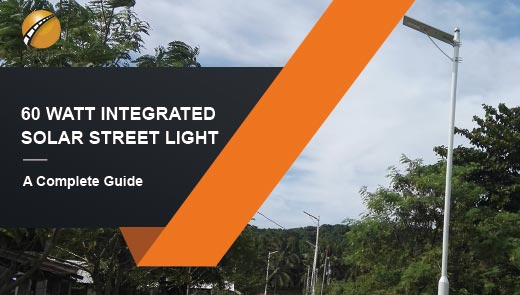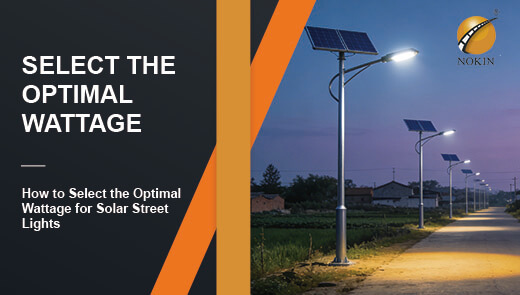How Solar Street Lights Help With Light Poverty?
In many regions around the world, "night" is not merely a natural continuation of day, but rather an invisible barrier to development - this is "light poverty". It does not merely refer to "no lighting", but rather a comprehensive predicament where the lack or instability of power supply has led to a long-term shortage of sufficient and reliable lighting in the area, thereby restricting residents' safety, economic activities and social life.
The emergence of solar street lights has provided a brand-new path to solve the problem of light poverty. It does not rely on the power grid. It absorbs sunlight through solar panels and converts it into electricity, storing energy during the day and providing lighting at night. The application of LED light sources also endows them with the advantages of low energy consumption and long lifespan. This "off-grid, sustainable and low-cost" feature precisely matches the needs of light-stricken areas, becoming the "green key" to illuminate the darkness.
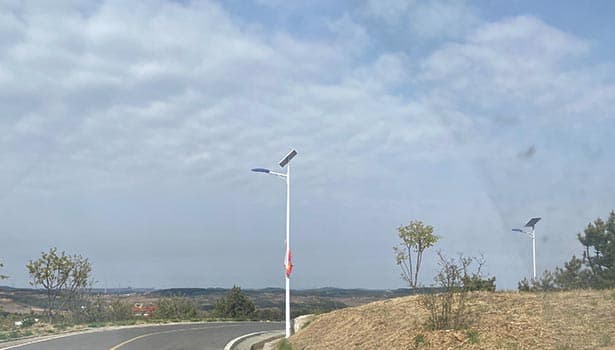
Development Obstacles Brought by Light Poverty
In rural areas south of the Sahara in Africa, approximately 70% of the residents have no access to stable power grids. In some remote mountainous areas of Asia, even when connected to the power grid, power outages of 4 to 6 hours a day are often the norm due to insufficient power supply capacity. In these areas, nights are often plunged into total darkness.
For residents, poverty alone means that when going out at night, they have to run the risk of falling and colliding on bumpy roads. For small vendors, sunset means business is over and they cannot increase their income by extending their business hours. For children, after dusk, the conditions for learning are lost. They can only read books under the dim kerosene light with difficulty, which not only harms their eyes but also limits the opportunity to acquire knowledge.
What is even more serious is that poverty alone has exacerbated safety hazards. Alleys and squares lacking lighting have become breeding grounds for criminal activities. The incidence of robbery and theft cases at night is often 2 to 3 times that during the day. It can be said that poverty alone is like a "dark barrier", hindering the progress of community development.
Improvement of Community Safety Brought By Solar Street Lights
Safety is the foundation of community development, and adequate lighting is the "first line of defense" for safety. Solar street lights build a safety barrier for residents by providing stable night lighting, reducing the risk of crime and preventing accidents.
Reduce the Risk of Crime
Criminal psychology research shows that perpetrators often tend to choose dimly lit and low-visibility environments to reduce the probability of being discovered. The continuous and uniform lighting provided by solar powered street lights precisely breaks this "dark protective color".
A global provider of solar lighting solutions once mentioned in its case report that in a slum in Mumbai, India, after installing solar street lights, the number of night robberies dropped by 62% within three months, and the residents' sense of security when traveling at night rose from 2.3 points (out of 10) to 7.8 points.
The logic behind this is quite simple: Adequate lighting keeps pedestrians, house doors and Windows, and public facilities clearly visible. This not only makes potential criminals give up committing crimes because they are "easy to be detected", but also encourages residents to go out at night, creating an atmosphere of "community supervision" and further curbing criminal activities.
Prevent All Kinds of Accidents
Nighttime accidents in poverty-stricken areas often stem from "invisible hidden dangers" - potholed roads, obstacles along the roadside, pedestrians and vehicles at intersections. These risks that are easy to avoid during the day may cause accidents in the dark.
In the suburbs of Kisumu City, Kenya, the local community used to experience an average of 8 pedestrian falls and fractures and 5 motorcycle and bicycle collisions each month due to a lack of lighting. In 2022, after 120 solar street lights were installed in this area, the number of related accidents dropped to one per month within six months.
For pedestrians, solar LED street lights illuminate the potholes, gravel and water accumulation on the road surface, preventing falls due to unclear road conditions. For drivers, clear lighting enables them to spot pedestrians and non-motorized vehicles on the roadside in advance, reducing the need for emergency braking or failure to give way in time. This "visible safety" has transformed night travel from an "adventure" into a "reassuring" experience.
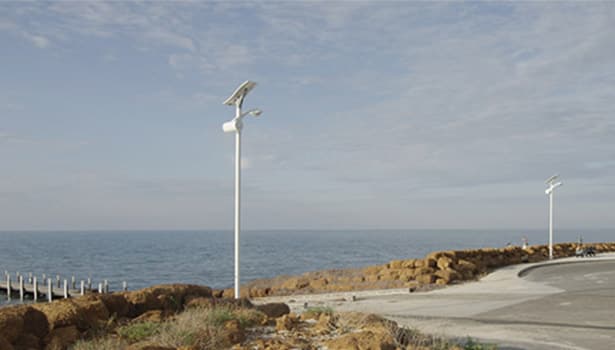
Economic and Social Value Brought By Solar Street Lights
If safety is the foundation, then economic vitality and social cohesion are the core of community development. Solar street lights inject development momentum into poverty-stricken areas by extending business hours, enriching community life and promoting education.
Extend the Business Operation Time
In many poverty-stricken areas, small-scale businesses such as small vendors, grocery stores and tailor shops often follow the pattern of "working at dawn and going to bed at dusk" - not because they don't want to extend their business hours, but because of the lack of lighting, they are unable to serve customers at night.
Dialogue magazine once conducted a survey on small businesses in the suburbs of Accra, Ghana: Before the installation of solar street lights, 85% of local small vendors closed their shops after sunset (around 18:30). After the installation of solar street lights, 68% of the vendors chose to extend their business until after 9:00 p.m., and some restaurants and daily necessities stores even stayed open until 10:30 p.m.
Correspondingly, the monthly revenue of these vendors has also seen a significant increase. Local tailor Akuya said, "Before, I could only wait at home at night. Now that the solar powered street lights are on, it's very convenient for customers to come after work to have their clothes made and picked up. My monthly income has risen from 300 sedi to 550 sedi."
This virtuous cycle of "extending business hours - increasing revenue - expanding operations" not only boosts the income of individual merchants but also creates new job opportunities - some stores, due to improved business, have started to hire additional helpers, indirectly easing the local employment pressure.
Enrich the Community Life Scenarios
Poverty not only restricts economic activities but also brings the night life of the community to a "standstill". Without lighting, residents dare not go out at night, and scenes such as community activities, social gatherings, and cultural entertainment are almost blank. In the long run, this can easily lead to weak community cohesion.
In the rural areas of Kampala, Uganda, local community centers used to hold events during the day due to a lack of lighting, with very few participants. In 2023, after the community installed 6 outdoor solar street lights, the situation changed: the "Community Reading Club" held every Wednesday evening had a fixed venue, and the "Handicraft Exchange Market" held once a month could also be held at night. The number of participating residents increased from the initial dozen or so to nearly a hundred.
"Before, I could only stay at home at night. Now that the solar street lights are on, I can read books, exchange ideas and do handicrafts with my neighbors. It feels like our relationship has become closer." " Local resident Martha said. The resumption of such night-time community activities not only enriches the spiritual life of residents but also promotes knowledge sharing and skill exchange, gradually creating a "vibrant and warm" atmosphere in the community.
Enhance Educational Accessibility
For low-income families in poverty-stricken areas, "electricity" is an expense that requires careful calculation. Many families turn off the lights after dusk to save on electricity bills, forcing children's after-school learning to be interrupted - this has become an important factor restricting educational equity.
In the Pokhara Mountain area of Nepal, local public welfare organizations once conducted statistics: Before the installation of solar led street lights, about 70% of primary school students had less than one hour of after-school study time each day due to the lack of lighting at home. After installing solar street lights, the community set up "night study corners" in public Spaces. Children can read books and do homework under the street lights, and their average after-school study time has been extended to 2.5 hours.
The "free lighting" provided by solar powered street lights not only resolves the "electricity anxiety" of low-income families but also creates a stable learning environment for children, making "after-school learning" no longer restricted by family economic conditions and contributing to the implementation of educational equity.
Sustainability and Cost Advantages of Solar Street Lights
The development of poverty-stricken areas alone requires not only "short-term problem-solving", but also "long-term sustainability". The advantages of solar street lights in terms of energy independence, cost control and environmental protection make them a "long-term choice" for light-stricken areas.
Realize Energy Independence
The core reason why many light-stricken areas have long lacked lighting is that they cannot be connected to the traditional power grid - either they are located in remote areas and the cost of extending the power grid is too high. Either the power supply from the grid is unstable, and frequent power outages render the lighting ineffective.
The "off-grid feature" of solar led street lights precisely resolves this issue. It generates electricity independently through solar panels. During the day, the electricity is stored in the battery, and at night, the controller automatically lights up the LED lights. The entire process does not rely on the power grid.
On the remote islands of Papua New Guinea, local residents had never used stable electricity before and could only rely on torches and kerosene lights for lighting at night. In 2024, after the installation of 200 solar street lights in the local area, the main roads and community centers achieved "stable lighting for 6 to 8 hours every night", and residents saw clear roads for the first time at night. More importantly, these street lights are not restricted by the power grid. Even in the event of extreme weather conditions such as typhoons or heavy rain, power supply can be restored as soon as the weather clears up.
Reduce Long-Term Operating Costs
The pain point of traditional lighting solutions (such as grid-powered street lights and diesel generator lighting) lies in the high long-term operating costs. Although solar street lights require a certain initial installation investment, in the long run, their cost advantage is very obvious.
The following table shows the cost comparison between solar street lights and traditional grid street lights (taking 1 light with a 5-year service life as an example) :
|
Cost Type |
Solar Street Lights (USD) |
Traditional Grid Street Lights (USD) |
Cost Difference (USD) |
|
Initial Installation Cost |
483 – 621 |
690 – 966 (including grid extension) |
207 – 345 |
|
Annual Electricity Cost |
0 (solar power supply) |
83 – 110 (LED light source) |
Solar street lights save 83 – 110 per year |
|
Annual Maintenance Cost |
14 – 21 (battery inspection) |
28 – 41 (line inspection and light source replacement) |
Solar street lights save 14 – 21 per year |
|
Total Cost Over 5 Years |
524 – 676 |
1,104 – 1,449 |
Solar street lights are lower by 579 – 773 |
As can be seen from the table, within a five-year period, one solar street light saves $579 to $773 compared to a traditional grid street light. For communities in poverty-stricken areas, this "one-time investment, long-term cost-saving" model has significantly reduced the economic pressure on lighting and prevented them from being abandoned due to excessively high subsequent costs.
Protect the Ecological Environment
The development of poverty-stricken areas alone should not come at the expense of the environment. Traditional diesel generator lighting generates a large amount of harmful gases such as carbon dioxide and sulfur dioxide, which not only pollutes the air but also exacerbates climate change. Solar street lights, on the other hand, rely entirely on clean energy to achieve "zero emissions".
Take 100 solar street lights as an example. Assuming each light illuminates for 8 hours a day, approximately 14,400 kilowatt-hours of electricity can be saved annually (calculated based on the LED light source power of 15W). According to the data from the National Energy Administration, each kilowatt-hour of electricity produced emits approximately 0.785 kilograms of carbon dioxide. Therefore, 100 solar street lights can reduce carbon dioxide emissions by about 11.3 kilograms ×100×365= 11.3 tons annually. 14,400 degrees ×0.785kg/degree = 11.304 tons.
This "green lighting" model not only enables light-stricken areas to solve their lighting problems while avoiding environmental pollution, but also aligns with the global trend of "carbon neutrality", laying a foundation for the long-term ecological development of communities.
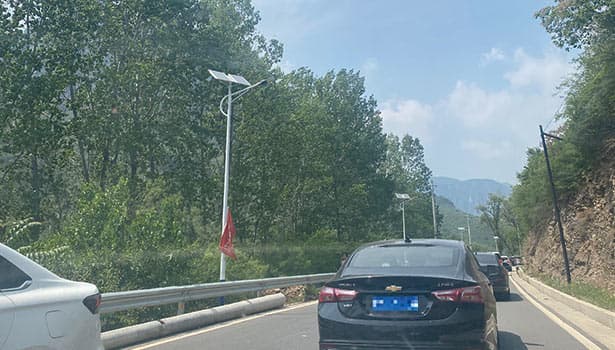
Convenience of Installation and Maintenance of Solar Street Lights
For poverty-stricken areas, the solutions should not only be "effective" but also "easy to implement". The convenience of solar street lights in installation and maintenance enables them to be quickly promoted in remote areas, avoiding the difficulty of popularization due to "complex operation".
Adapt to Off-Grid Scenarios
The installation of traditional power grid street lights requires the extension of power grid lines first. In mountainous areas, islands and other regions with complex terrain, laying cables requires excavating roads and crossing rivers. Not only is the construction period long (usually 1 to 3 months), but it also damages the local ecological environment.
The installation of solar street lights is much simpler: just select an appropriate installation point (such as by the roadside or beside a utility pole), lay a solid foundation, fix the light pole, and then connect the solar panels, batteries and lights. The entire process does not require the laying of cables.
In the mountainous area of Luzon Island, Philippines, when the local community installed 50 solar street lights, it only took 5 days to complete the entire construction - the construction team worked 8 hours a day, and the average installation time for each light was less than 2 hours. This "quick installation" feature enables light-stricken areas to achieve lighting coverage in a short period of time, avoiding long-term darkness due to long construction periods.
Reduce the Burden of Maintenance
Communities in poverty-stricken areas often lack professional maintenance personnel. If lighting equipment needs frequent maintenance, it is very likely that there will be a situation where "no one repairs it when it breaks down". The design of solar street lights precisely takes this demand into account and features "low maintenance".
The core components of solar street lights (solar panels, LED light sources, and batteries) have a long lifespan: the service life of solar panels can reach 20 to 25 years, that of LED light sources can reach 5 to 8 years, and that of batteries can also reach 3 to 5 years. In daily use, it is only necessary to check the battery's power storage condition every six months to one year and regularly clean the dust on the solar panels. There is no need for complex maintenance operations.
Solar street lights are not just "one light", but "all-rounders" in solving the problem of light poverty. With the continuous advancement of solar energy technology, solar street lights will be implemented in more poverty-stricken areas, becoming the "green key" to illuminate community development. In the future, we look forward to seeing more regions bid farewell to darkness thanks to solar street lights and embrace a new future that is safe, prosperous and sustainable.

